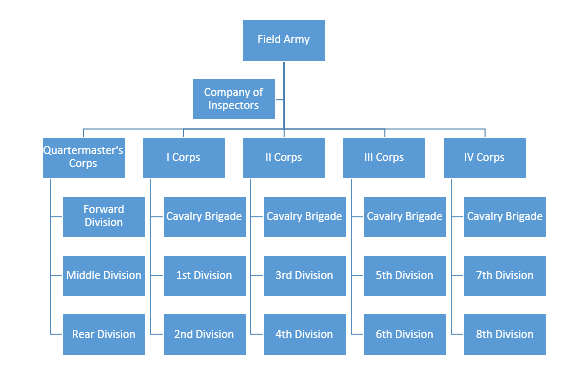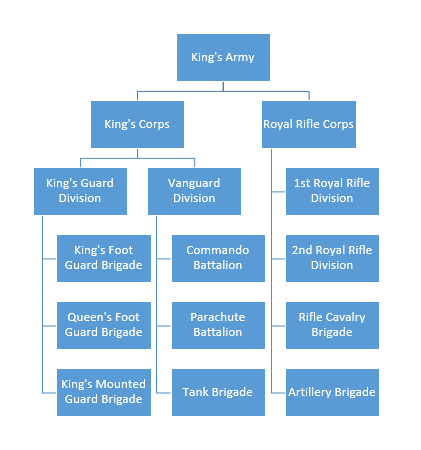When the Kingdom of North Mississippi came into being, its armed forces consisted of three departments. The Royal Army, at the time made up of occupying Commonwealth and Mississippi Empire units, was by far the largest. The Royal Navy, consisting of a few boats and personnel, was the smallest. And the Royal Service, supporting both army and navy, was the most under-strength.
Over the years the military grew in size and complexity, dividing themselves as necessary. The Royal Navy has so far avoided any divisions, while the Royal Army has split into six branches and the Royal Service into three.
The ten specific branches are:
- Adjutants’ Corps – Responsible for administration, training and medical support
- District Forces – The defensive and policing force for the majority of the kingdom.
- Field Army – The offensive force
- Inspectorate – Responsible for intelligence, counter intelligence, prisons, signals, and security
- King’s Army – The troops who garrison the large metropolitan area.
- Ministerial Troops – Military and security forces controlled by civilian ministries
- North Watch – Guardian troops who protect the northern border against Quebec
- Royal Air Corps – The formation of air planes and their support personnel.
- Royal Navy – Responsible for warfare on Lake Superior and along the various rivers and lakes
- Quartermaster’s Corps – Responsible for Logistics and Fortifications
Adjutants’ Corps
- Commander: Lieutenant General
- Uniform Color: Red
- Ranks: A mixture of army and navy.
The Adjutant’s Corps started as the staff corps of military, providing administrators, records keepers and aides. Over the years, several additional responsibilities were moved under the Adjutant’s responsibility as part of the political infighting of the higher generals. In addition to staff duties in every headquarters of battalion level or higher, the Adjutant’s Corps is responsible for training conscripts and volunteers, overseeing medical facilities, and handling money and pay matters.
District Forces
- Commander: Marshal General Herschel Robinson
- Uniform Color: Dark Blue
- Ranks: Army only
District Forces are the largest branch, with the vast majority of conscripts heading into their ranks. Battalions are concentrated around urban centers, where they fulfill two roles. First, they watch the civilians and provide support against any civil unrest. Second, they defend the cities from outside attack, turning each one into a fortress.
Expectations of the District Forces are low. Their large size means very few conscripts are rejected, and better soldiers are often sent into other branches. Due to this, most conscripts end up serving in battalions distant from their homes, to avoid familiarity that might lead to battalions joining in civil unrest
Field Army
- Commander: Field General Prince Stefan Santiago-Locke
- Uniform Color: Dark Brown
- Ranks: Army only
The Field Army is the offensive component of the North Mississippi military. It is responsible for counter-attacking any foreign invasion, or to launch their own invasion is necessary.
Originally a corps-sized formation of less than ten thousand men, General Prince Stefan has waged a war of political wills to grow it into a formation of almost sixty-thousand that exists independently of Marshal Robinson’s control. Each of the army’s four corps is capable of fighting independently of each other if necessary.
The Field Army of North Mississippi

Inspectorate
- Commander: General Henry Lavern
- Uniform Color: Dark Grey
- Ranks: Mix of Army and Navy
The Inspectorate is primarily concerned with security and counter-intelligence. Inspectorate officers investigate crimes and traitors across all the other branches. Their troops also run and maintain the various political and military prisons that dot North Mississippi.
King’s Army
- Commander:
- Uniform Color: Dull Green
- Ranks: Army ranks only
The King’s Army is the formation of troops that protects the Royal Cities and the king’s castles therein. This is not to be confused with District Troops in the Royal Cities District.
The King’s Army protects and patrols the Royal Cities, the largest metropolitan area in the kingdom. In peace time they are separate from the garrison troops who man the local fortresses; in war time they King’s Army assumes command of the district troops.
The King’s Army is divided into two corps. The Royal Rifle Corps (13,000 troops) is a two-division corps with its own artillery and cavalry brigades. The King’s Corps (6,500) consists of the guards who actually guard the king in the aptly named King’s Guard Division, and the Vanguard Division, where the expensive specialist troops are (including the Tank Brigade and the Commando Battalion).

Ministerial Troops
- Commander: Major General
- Uniform Color: Khaki
- Ranks: Mix of Army and Navy
The Ministerial branch is an umbrella organization that provides soldiers and specialists for the other governmental agencies. Troops from this branch provide security and signal technicians for North Mississippi embassies across the world, armed soldiers for the tax columns that cross the country every fall, and wardens at the common prisons.
North Watch
- Commander: Lieutenant General
- Uniform Color: Forest Green
- Ranks: Army Only
The North Watch is a corps-sized formation that stands guard over the North Mississippi – Quebecois border.
It is a hold-over from the Iron Republic, who maintained a similar formation in the same place. King Xavier upgraded and expanded the fortifications into three forts known as the three bears: Ursa Major, Ursa Minor, and Ursa Superior. In addition to the garrison and support troops (approximately three thousand troops total), the North Watch consists of three infantry brigades, two cavalry brigades, and one artillery brigade, another 11,000 troops.
Royal Air Corps
- Commander: Major General Larbi Bennabi
- Uniform Color: Off-White
- Ranks: A mixture of army and navy.
The Charter of North Mississippi requires the kingdom to maintain an air force of some size, otherwise the Royal Air Corps might not exist. King Xavier has a distrust of technology, including air craft of all forms.
The RAC is commanded by a former Imperial Commonwealth officer, and has the highest ratio of warrant officers to commissioned officers in the Royal Military. They maintain one air base in the Royal Cities, and a dozen minor facilities spread out around the kingdom. Training and maintenance is limited, with air crews grounded all but a handful of days out of the month.
As for aircraft, the RAC has on paper 51 aircraft divided into 17 flights of three aircraft each. These flights are grouped into squadrons based on their roles. Except for the patrol aircraft, permanently stationed in Duluth, all aircraft are held at the main Air Base in the Royal Cities.
- Attack Squadron – 4 Flights, 12 Aircraft
- Bomber Squadron – 3 Flights, 9 Aircraft
- Fighter Squadron – 6 Flights, 18 Aircraft
- Patrol Squadron – 1 Flight, 3 Aircraft
- Transport Squadron – 3 Flights, 9 Aircraft
Royal Navy
- Commander: Admiral Yuri Rokossovsky
- Uniform Color: Black
- Ranks: Navy only
The Royal Navy commands the military ships of North Mississippi, both of the Lake Fleet on Lake Superior, and the River Fleet on the Mississippi River.
The Lake Fleet is by far the largest. Centered around two lake battleships, the Lord of the Lake and the Sovereign of Superior, with a handful of frigates and sloops in support.
The River Fleet consists of scores of sailing boats, river barges and heavy monitors.
The Royal Navy also crews the two royal yachts: the Queen Natalie on Lake Superior and the Princess Samantha on the Mississippi River.
Quartermaster’s Corps
- Commander: General Ernesto Aguilar
- Uniform Color: Light Blue
- Ranks: Army and Navy
The Quartermaster Corps is responsible for supplying the military units, building their bases, and manning the fortresses of the kingdom. Most quartermaster personnel work in the ‘trains’, transporting goods and supplies. Fortresses are the second largest number, as every city of the kingdom has at least one fortress to aid in its defense. Finally come the construction companies, responsible for building and rebuilding as needed.